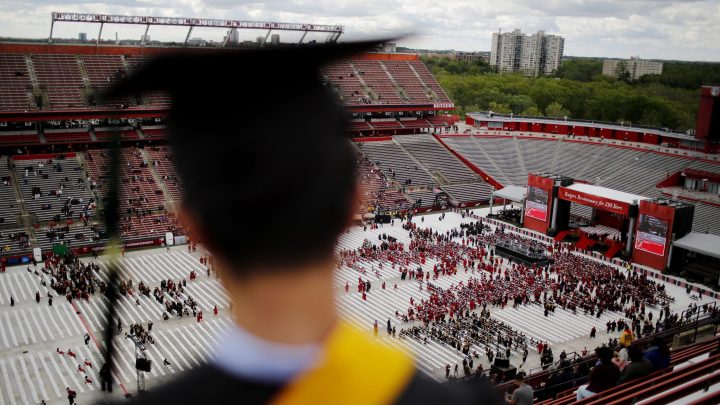
Getting private scholarships for college doesn’t necessarily mean a reduced bill
Getting private scholarships for college doesn’t necessarily mean a reduced bill

In many places, we are just a few weeks away from the start of the fall semester of college. Which means that right around now, the bill for that semester is arriving. Some students win private scholarships from companies or foundations, which they expect to be able to put toward those bills.
But if those students are also getting money from the college to attend, sometimes the school will take that private scholarship money and subtract that amount from its institutional grant. This is referred to by some in higher education as “the August surprise.” It’s known more formally as scholarship displacement, and some states are passing laws to end it.
One student who’s dealt with this is Emily Liang, who grew up in Oakland, California. Both of her parents are originally from China. They don’t speak English, and Liang recalls helping her mom fill out an application for a food service job back in middle school.
“I remember writing her resume for her,” said Liang. “That was my first career professional development thing, I would say.”
Her mom got the job, and in high school, Liang started filling out her own applications for scholarships to help pay for college.
“I had an ongoing Excel sheet of just all the different scholarships I could apply to,” said Liang.
She said she got a couple big national ones, along with some smaller local ones, and a generous financial aid package from Stanford, where she decided to enroll in 2020.
Part of the financial aid calculus for students at Stanford includes a portion they’re expected to contribute themselves, which they can earn by working. For most students, it’ll be at least $5,000.
“I remember asking financial aid whether I could use my outside scholarships to cover that. And they said no, that would just eat up my Stanford scholarship. It wouldn’t necessarily be applied to that,” said Liang.
In other words, the private money would have displaced part of what Stanford was offering her. Liang said as a first generation college student from a low income family, this was really frustrating
“If your end goal is to support students in their journey to college, they should have that financial freedom on how to use their money,” said Liang.
A number of elected officials feel the same way. At least six states have laws limiting or banning scholarship displacement, according to a count by the National Conference of State Legislatures. That includes Washington, California, New Jersey, Pennsylvania, Maryland and Minnesota. Other states are considering legislation.
Stanford said that students can use outside scholarships to pay their contribution. But it still has to adhere to federal regulations that say colleges can’t give students more financial aid than they actually need to attend.
Other colleges point to these federal rules, as well.
“There are some students who have really robust financial aid offers or really large scholarships, where that need figure is met, and then something needs to be reduced,” said Lo Klink, associate director for special awards and student engagement in the Office of Student Financial Aid at the University of Wisconsin-Madison.
So, if a private scholarship puts a student over the top, then the school may reduce its institutional grant. Klink said that goes back into a pool of money to be reallocated to other students.
“It can allow an institution, particularly under resourced institutions, to spread their wealth even further,” said Klink.
Still, this practice of denying institutional aid when a student is awarded outside grants isn’t what private scholarship providers had in mind. Kalwis Lo is director of strategic partnerships for Scholarship America, which awards its own funds and distributes grants on behalf of foundations and companies.
“The reason why they’re doing this is because they’re making huge investments in their future workforce,” said Lo. “They want an educated and skilled workforce that they can draw from, hire from.”
The private sector gave out about $12 billion in scholarships to undergraduates in the school year ending in 2022, according to an estimate from the College Board.
And companies want that money to work for them.
“We have so many corporations who talk about hiring diverse staff … and the only way to have those type of employees available is to educate them,” said Lo. “So this is partly around charity, but also it’s an investment.”
Lo said scholarship displacement could discourage donors from offering money in the first place, and discourage students from applying.
That’s the case for Stanford senior Emily Liang, who said if she’d known about the practice earlier, she would have focused her efforts elsewhere.
“Honestly, I wouldn’t have worked as hard for scholarships,” said Liang.
Which also means, she said, she wouldn’t have received the mentoring and networks that came with them.
She also would like to see schools and scholarship providers take into account all the costs students incur, along with tuition and housing.
“What’s not covered is dental expenses, medical expenses,” said Liang. “A flight going back home because your parents are sick.”
Liang said there are lots of factors and expenses involved with helping students succeed, and if they earn scholarships, they should be able to use that money for whatever they need.
This story was a collaboration with The Hechinger Report, a nonprofit that covers education.
There’s a lot happening in the world. Through it all, Marketplace is here for you.
You rely on Marketplace to break down the world’s events and tell you how it affects you in a fact-based, approachable way. We rely on your financial support to keep making that possible.
Your donation today powers the independent journalism that you rely on. For just $5/month, you can help sustain Marketplace so we can keep reporting on the things that matter to you.

















